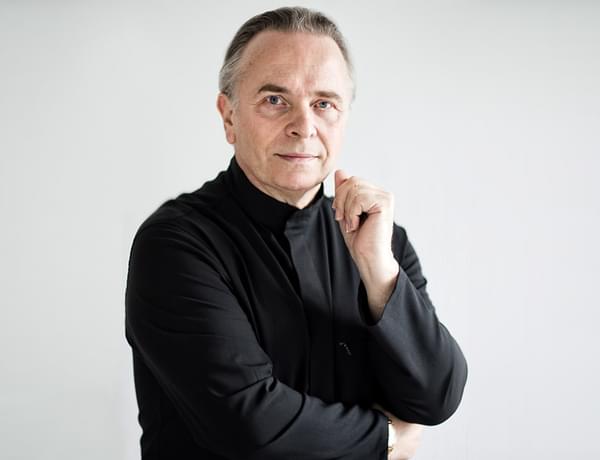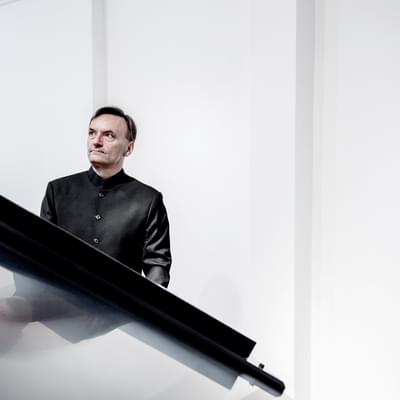Sir Mark Elder conducts Brahms & Shostakovich

Full programme
- Brahms, Piano Concerto No.1 (47mins)
- Janáček, The Fiddler's Child (10mins)
- Shostakovich, Symphony No.6 (30mins)
Performers

Sir Mark Elder
Conductor
Sir Stephen Hough
Piano
Introduction
It is more than 25 years since I last made music with your wonderful orchestra – so it is very exciting to be back with them. I wonder how many people will I recognise? In the 1990s we did so many different projects together and I have many happy memories of those years.
Tonight, my very old friend, Stephen Hough, is with us to play Brahms’ D minor concerto. The music’s association with Robert Schumann is well known. It is a profoundly moving work as much in the quiet stillness of the central movement as in the turbulence and fire of the outer two.
Janáček was deeply moved by the Czech tone poems of Dvořák and was inspired to write one himself. This touching tale of village life, death and supernatural events are mirrored in the narrative of the score. You may notice the many passages for four solo violas. Janáček said that they represented the four walls of the huts in which so many poor people lived. By contrast, the solo violin soars above the orchestra reflecting the artistry and passion of the village fiddler.
Throughout his long life in Stalinist Russia, Shostakovich never shook off the danger of being persecuted for the essence of the music he wrote. His three movement sixth symphony created quite a stir – everyone thought it was unfinished! But I always feel that the darkness and tension in the first movement expresses something akin to insomnia. It is fifteen minutes long – exactly half of the work. The muscularity and forward momentum of the remaining movements has been deeply earnt.
As you will see, they differ from each other considerably. What feels threatening in the second movement is transformed into skittish high spirits in the third. The symphony erupts into circus music by the end leaving us with a feeling of forced hilarity.
This concert promises to be amazing, with a programme that shows the fantastic vitality of the orchestra.
Sir Mark Elder
Conductor
Programme notes
Former Principal Guest Conductor, Sir Mark Elder, makes a welcome return after more than 20 years with a wonderful programme. Brahms is on majestic form in his first Piano Concerto brought to dramatic life by Sir Stephen Hough. Janáček packs a punch with his tale of the fiddler, his sick child – and authoritarian oppression. Shostakovich knew a thing or two about that. His Symphony No.6 builds from slow start to wild conclusion – one of his most diabolical finales.
Piano Concerto no.1
Johannes Brahms (1833-1897)
Brahms’ Piano Concerto no. 1 is frequently described as ‘stormy,’ or ‘intense’ or even ‘ferocious’. It is, certainly, a work which both was and sounds like a struggle (another word which crops up a lot). Brahms began what eventually became his first Piano Concerto in 1854. He originally conceived it as a two-piano sonata, then a symphony, most of which he discarded, before shaping the material into the Piano Concerto and finally completing it in 1858. The intensity of the work mainly belongs to the first movement; the second was intended as a ‘gentle portrait’ of Clara Schumann, while the third is a relatively jaunty rondo. But despite the trajectory from turbulence to optimism the critics were brutal after the 1859 premiere. Edward Bernsdorf wrote ‘The work…has nothing to offer but waste… a dessert of the shrillest dissonances and most unpleasant sounds.’ There’s no need to return your ticket, however, as this is one of those responses that makes one wonder whether the critics were listening to the same piece.
The opening movement begins with a series of noisy statements: timpani rolls, loud trills in the strings, and a pounding theme. For the first four minutes or so, you would be forgiven for thinking Brahms has forgotten this is a piano concerto, given the abundance of orchestral themes and no sign of the soloist. When the piano does enter, it is with an unobtrusive melody of its own. It gets gradually sucked into the orbit of the opening gestures, yet shortly after emerges with a stately, major key passage, ushering in a gentler mood. Rippling arpeggios underpin a hunting-style solo from the horn, considerably more rhapsodic in tone, before abruptly returning to the turbulent mood of the start. Piano and orchestra continue to alternate, or combine for either ecstasy or argument, until the close of this powerful movement.
Clara Schumann, the subject of the second movement, discerned in it a spiritual quality. Indeed Brahms wrote ‘Blessed is he that cometh in the name of the Lord’ above the first theme, and despite some agitation at its centre, the movement has a long-breathed serenity throughout. An improvisatory-sounding solo passage wanders, as if accidentally, into a short cadenza (there is another one in the finale), but it is suitably thoughtful rather than a frenzied gallop up and down the keyboard. The third movement leaps into action with an energetic piano solo and the atmosphere feels initially like a return to the first movement, with its trills, horn fanfares, and stern key of D minor. A portentous timpani roll introduces the cadenza about halfway through. But gradually, a brighter major key intervenes and becomes dominant, leading to a joyful, dance-like theme in the final moments, the timpani roll now triumphant rather than ominous.
The Fiddler’s Child
Leos Janáček (1854-1928)
By the time he completed The Fiddler’s Child in 1914 Janáček was steeped in stories. He had written several operas, including the passionate Jenůfa and the satirical The Excursions of Mr. Brouček to the Moon and the Fifteenth Century. So when a commission for an orchestral work came he turned to a tragic tale by Svatopluk Cech for inspiration, though he altered it considerably. In the original poem a destitute fiddler has died, leaving his sick child – as well as his violin - in the care of an old woman. At night, the woman sees the ghost of the fiddler, luring his child to him with his fiddle; the woman repels the apparition with a crucifix. The Mayor arrives the next morning to find the woman holding the now lifeless child, the violin vanished. The woman is banished for losing both child and violin. Although the poem was reproduced alongside the published score, Janáček’s narrative emphasises the cruelty of the Mayor. He gives him an uncompromising motif of four accented crotchets, heard first on the cellos and bass, then dominating the final moments in a sad, somewhat hopeless, trudge. As Nigel Simeone has written, the Mayor is a symbol of oppression: ‘it is thanks to people like him that the fiddler and his child suffered in the first place.’
Instrumental associations more generally were key to this work. In a note accompanying the projected first performance, Janáček wrote that once a theme became attached to an instrument – to its ‘phosphorescence of timbre’ - the two become inseparable. Janáček noted that the violin, is, inevitably, associated with the fiddler throughout, from its opening ‘fading’ motif, to its promises of ‘golden dreams’ for the child – an especially beautiful passage. A solo oboe briefly, poignantly, represents the dying child. A warm group of violas, meanwhile, embodies the ‘soul of the people’. In the final bar, they are not entirely vanquished, and give two defiant bursts of semiquavers (albeit in pianissimo).
Symphony no.6
Dmitri Shostakovich (1906-1975)
Leonard Bernstein once mused of Shostakovich’s Symphony no. 6: ‘What kind of symphony is this?’. Of its many unconventional qualities Bernstein notes the long, slow first movement – a ‘personal prayer’, a ‘hypnotising meditation’ - and that it is followed by ‘two short, sharp, funny, even ridiculous little movements. … Bing, bang and zip it, it’s over’.
Bernstein also remarks that it is one of Shostakovich’s least-performed works, possibly because of this curious, lop-sided structure. Critics were baffled at the premiere in 1939, partly because Shostakovich had announced the previous year that he was intending to write a symphony in tribute to Lenin complete with soloists and chorus, bursting with ‘folklore’. None of these elements made it to the final draft. Instead, we are presented with a fascinating enigma, full of grief and portent (in the first movement), then becoming increasingly carnivalesque by the finale.
The Largo – some 20 minutes in duration – opens with a unison theme, followed by a second theme with a snarling trill at its centre. These form the basis of the whole movement. While the symphony is scored for large orchestra, there are swathes of chamber-like music and isolated woodwind solos giving a sense of loneliness and vulnerability. This is especially so when set against passages of seriousness, even menace, for low strings and stentorian horns. In the final quarter of the movement a horn solo, which in other contexts might glow with warmth, is accompanied by a chilly celesta and high strings. In the final few moments, the orchestral texture is threadbare and utterly desolate.
None of this would prepare the listener for the sprightly appearance of a high clarinet at the start of the second movement. Its somewhat harsh tone kicks off a scrambling scherzo which – at first – seems high-spirited, but takes on a disturbingly feverish quality. This is further emphasised by a rattling xylophone and a series of short-lived, hectic themes, each piling on rapidly after the other. Things take an even more diabolical turn with the unleashing of the percussion and a cackling unison for the rest of the orchestra. It concludes with a strangely insouciant horn chorale and a wisp of woodwind.
The finale opens with one of Shostakovich’s favourite rhythms, resembling the ‘gallop’ from Rossini’s William Tell overture. And ‘gallop’ is about right for the character of this movement, though it does return briefly to the lonely mood of the Largo. For the most part it is a breathless whirl concluding with a full-blooded knees-up in the brass.
What Shostakovich had in mind with this journey from sombre desolation to frantic good humour is anyone’s guess. But the humour in Shostakovich’s music is often tinged – at the very least – with a grim awareness of suffering. Amidst the circus of the third movement, we should still remember the anguish of the first.
© Lucy Walker